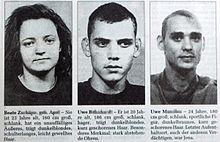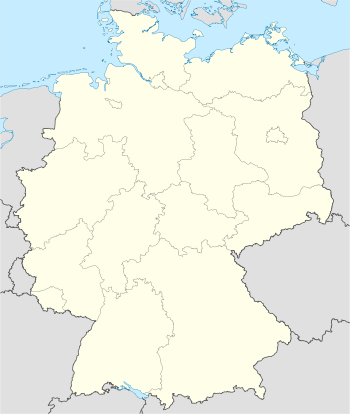- Bosphorus serial murders
-
 Suspects of Bosphorus serial murders[1]
Suspects of Bosphorus serial murders[1]
The Bosphorus serial murders[2] also known as Döner murders, the term often used by the media[3], were a series of murders that took place in Germany between 2000 and 2006, leaving ten people dead and one wounded. The perpetrators called themselves National Socialist Underground (NSU) (German: Nationalsozialistischer Untergrund). The primary target of these right-wing extremist-oriented crimes were predominantly immigrants of Turkish origin and one person of Greek origin.
The victims were mostly small business owners (doner kebab vendors, grocers, locksmiths, alteration tailors, internet café) who were murdered in broad daylight by being shot in the face with a CZ 83. According to the parents of the Turkish victim who worked in an internet café, the police originally suspected foreign organised criminals. Furthermore, a German policewoman, Michéle Kiesewetter, was shot as well and her partner was critically wounded. Other crimes, in particular a bomb attack, have allegedly been committed by the group. The murders, according to the acting Attorney General of Germany, Rainer Greisbaum.[4], have Neo-Nazi links. The German authorities identified three suspects, Uwe Böhnhardt, Uwe Mundlos, and Beate Zschäpe as responsible for the murders and attempted murders. Böhnhardt and Mundlos were found dead by police after they robbed a bank on 4 November 2011. Police say they committed suicide [5]. Zschäpe turned herself in on 11 November 2011. She will probably face charges of murder, attempted murder, arson, and belonging to a terrorist organization. Zschäpe is only willing to testify if she is considered a state witness, with mitigation of sentence.[citation needed] The police had discovered a hit list of 88 people later.[6]
Contents
Crimes involved
Murder of Enver Şimşek
Enver Şimşek, a business man with Turkish roots, was shot in the face next to his flower stall in Nuremberg, Germany, in the afternoon of 9 September 2000 by two gun-men. Two days later Şimşek, aged 38, died from his wounds in hospital, making him the first victim in the series. One of the guns used to kill Şimşek was to used in nine more murders. Şimşek's business comprised several flower stalls in southern Germany. When his employee running the stall in Nuremberg went on holidays, Şimşek himself stepped in for him.[7]
Murder of Abdurrahim Özüdoğru
On 13 June 2001, Abdurrahim Özüdoğru was killed by two shots in the head with the same weapon already used in the murder of Enver Şimşek. Özüdoğru, who worked as a machinist for a big company in Nuremberg, had been helping out in a tailor's shop. His death was discovered when a passer-by noticed through the shop window the lifeless body of Özüdoğru, sitting in the back of the shop, covered in blood.[7]
Murder of Süleyman Taşköprü
Two weeks after the second murder, Süleyman Taşköprü, aged 31, died in Hamburg-Bahrenfeld after being shot in the head three times in his green grocer's shop. The murder happened some time between 10:45 and 11:15 a.m on 27 June 2001. The same guns as in the first case were used, a CZ 83 and a 6.35 mm gun.[8]
Murder of Habil Kılıç
On 29 August 2001 Habil Kılıç became the fourth victim. His death was the first of two murders in Munich. Kılıç, aged 38, who was married and had a daughter, was shot at point-blank range in his green grocer's shop in the Westend of the city.[9]
Murder of Yunus Turgut
Two and a half years later, on the morning of 25 February 2004, Ash Wednesday, Yunus Turgut opened up a doner kebab shop in Rostock-Toitenwinkel. Turgut, who had been living illegally in Hamburg, was in Rostock on a visit and had been asked by an aquaintance to open up the shop that day. Between 10:10 and 10:20 Turgut was shot three times with a silenced CZ 83. Being hit in the head and neck he died instantaneously. Because of his link to Hamburg, Rostock police made the connection to the third victim, Süleyman Taşköprü, thus establishing the term doner murders,[10]
Murder of İsmail Yaşar
On 5 June 2005 the murders struck again for the third time in Nuremberg. İsmail Yaşar, aged 50, had come from Suruc, Turkey to Nuremberg, owned a kebab shop in Scharrerstrasse. He was found dead around 10:15 with five gunshot wounds. Police believed he had been shot and killed between 9:50 and 10:05 based on witness' statements.[11]
Murder of Theodoros Boulgarides
Theodoros Boulgarides was the second murder victim in Munich and the first non-Turk to die. Boulgarides, a locksmith, was killed on 15 June 2005 sometime between 18:15 and 19:00 in his shop in the vicinity of the location of the other murder in Munich. Boulgarides left a wife and two daughters.[12]
Murder of Mehmet Kubaşık
Mehmet Kubaşık, a kiosk vendor from Dortmund, was found dead in the early afternoon of 4 April 2006 in his shop. Kubaşık, who was a German citizen of Turkish origin, was shot in the head like most of the other victims.[13]
Murder of Halit Yozgat
Halit Yozgat was the last victim of the murder series. His death, only two days after Kubaşık's is the most mysterious. Yozgat, who ran an internet café in Kassel, Hesse, was shot in the head with a silenced gun, too. Only this time, an agent of the Hessian Office for the Protection of the Constitution was present. The agent claimed first to have left the premises shortly before the murder, but later changed his statement when presented with new evidence. Witnesses reported to have seen him on the scene when the murder happened. His involvement with the case gave rise to suspicions that government agencies might be somehow linked to the organisation responsible for the murders.[14][15]
Murder of Michéle Kiesewetter
Michéle Kiesewetter's death in a parking lot in Heilbronn on 25 April 2007 is considered by some to be linked to the Bosphorus murder series. This is mainly due to the fact, that she was killed by the same weapon as the other victims. Kiesewetter, who was a police officer, was killed, when she and her partner were attacked during lunch break. Her partner was critically wounded, but survived with no memory of the attack. While in the other cases the motive is assumed to be xenophobia and/or racism it is unclear why Kiesewetter and her partner were attacked. Theories about the murder include a variety of motives such as a personal link between Kiesewetter, who came from Thuringia as the alleged perpetrators, or the acquisition of firearms. The service pistols of Kiesewetter and her partner had been stolen and turned up later on the scene of the suicide of two of the alleged perpetrators.
Reactions
German Chancellor Angela Merkel stated that "the cold-blooded murders of nine immigrant shopkeepers by neo-Nazis is an “inconceivable” crime for Germany and a national disgrace."[16]
List of victims
Name Location Date Enver Şimşek Nuremberg 9 September 2000 Abdurrahim Özüdoğru Nuremberg 13 June 2001 Süleyman Taşköprü Hamburg 27 June 2001 Habil Kılıç Munich 29 August 2001 Yunus Turgut Rostock 25 February 2004 İsmail Yaşar Nuremberg 5 June 2005 Theodoros Boulgarides Munich 15 June 2005 Mehmet Kubaşık Dortmund 4 April 2006 Halit Yozgat Kassel 6 April 2006 Michèle Kiesewetter Heilbronn 25 April 2007 References
- ^ "Döner-Mörder: Waren sie Einzeltäter oder gibt es ein Netzwerk?" (in German). Deutsch Türkische Nachrichten. http://www.deutsch-tuerkische-nachrichten.de/2011/11/13/doener-moerder-waren-sie-einzeltaeter-oder-gibt-es-ein-netzwerk/. Retrieved 13 November 2011.
- ^ "Ungeklärte Fälle - Landespolizei Mecklenburg-Vorpommern" (in German). http://www.polizei.mvnet.de/cms2/Polizei_prod/Polizei/de/start/_Informationen/Fahndungen/Ungeklaerte_Faelle/index.jsp?&pid=16774. Retrieved 14 November 2011.
- ^ Kulish, Nicholas (14 November 2011). "Neo-Nazis Suspected in Wave of Crimes in Germany". The New York Times. http://www.nytimes.com/2011/11/14/world/europe/neo-nazis-suspected-in-wave-of-crimes-in-germany.html. Retrieved 14 November 2011.
- ^ "Video - Bundesstaatsanwalt: Polizisten- und Döner-Morde wohl Tat von Neonazis - Panorama" (in German). http://www.stern.de/panorama/bundesstaatsanwalt-polizisten-und-doener-morde-wohl-tat-von-neonazis-1750245.html. Retrieved 14 November 2011.
- ^ "Mordserie in Deutschland: Bundesrichter erlässt Haftbefehl gegen Beate Z. - Deutschland - FOCUS Online - Nachrichten" (in German). http://www.focus.de/politik/deutschland/mordserie-in-deutschland-bundesrichter-erlaesst-haftbefehl-gegen-beate-z-_aid_684001.html. Retrieved 14 November 2011.
- ^ "German neo-Nazi terrorists had 'hitlist' of 88 political targets". The Guardian. http://www.guardian.co.uk/world/2011/nov/16/german-neo-nazi-terror-hitlist?newsfeed=true. Retrieved 17 November 2011.
- ^ a b Süddeutsche Zeitung, 6. August 2010
- ^ Polizeinews, Hamburg, 18 July 2007
- ^ "München: Zwei der neun Döner-Morde in Ramersdorf und im Westend - Stadt München - München Stadt - Lokales - merkur-online" (in German). http://www.merkur-online.de/nachrichten/muenchen/doener-morde-muenchen-tatorte-meta-1487441.html. Retrieved 16 November 2011.
- ^ "Neonazi-Verbrechen: Der fünfte Mord - Inland - FAZ" (in German). Frankfurter Allgemeine Zeitung. http://www.faz.net/aktuell/politik/inland/neonazi-verbrechen-der-fuenfte-mord-11529616.html. Retrieved 16 November 2011.
- ^ BKA Bosporus
- ^ Münchner Abendzeitung, 14 November 2011
- ^ "Kopfschüsse in Dortmund: Serienmörder schlägt zum achten Mal zu - SPIEGEL ONLINE - Nachrichten - Panorama" (in German). Der Spiegel. http://www.spiegel.de/panorama/justiz/0,1518,410272,00.html. Retrieved 16 November 2011.
- ^ "Kasseler Mord in neuem Licht: Verdächtiger Verfassungsschützer - Inland - FAZ" (in German). Frankfurter Allgemeine Zeitung. http://www.faz.net/aktuell/politik/inland/kasseler-mord-in-neuem-licht-verdaechtiger-verfassungsschuetzer-11529097.html. Retrieved 16 November 2011.
- ^ Die Zeit, 17 November 2011
- ^ "World News: Series of murders by neo-Nazis ‘a disgrace,’ says Germany’s Merkel - thestar.com". Toronto Star. http://www.thestar.com/news/world/article/1086520--series-of-murders-by-neo-nazis-a-disgrace-says-germany-s-merkel. Retrieved 15 November 2011.
See also
- Michéle Kiesewetter
- Phantom of Heilbronn
- 2004 Cologne bombing
Categories:- 2000s crimes
- 2000s in Germany
- German mass murderers
- Murder in Germany
- Neo-Nazism in Germany
- Terrorism in Germany
- Terrorist incidents in the 2000s
Wikimedia Foundation. 2010.



